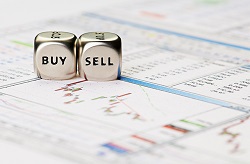Editor's Note: In today's markets, a buy-and-hold approach will only take your portfolio so far. With the trading orders Tom details below - first shared with readers in 2015 and again with you today - you can maximize your profits without being chained to your computer screen. Here's Tom...
In the world of investing generally - and options trading in particular - it is not only important to know when to get in and get out of a trade, it is also important to know how to do so.
Whether you still call trades into your broker, or enter them into an online platform, or use proprietary software to make your trades, the orders you give to your broker are incredibly important.
Retail investors used to just buy stocks at the market and wait for them to rise in value. But these days it's not enough to just buy stocks or shares of a mutual fund and sit on them for decades - this is not your father's market. Things have changed a great deal in the last 25 years.

Thanks to computers and the proliferation of the Internet, the markets move incredibly quickly, and you need to be prepared for whatever happens next.
That means tailoring your orders to fit your trades and having them into your broker ahead of time.
Today, I'm going to show you how you can maximize your profits (and minimize your losses) with just a few tweaks to your orders.
But first...
Take Emotion Out of the Equation
Average retail investors are typically what I call discretionary traders. A discretionary trader is someone who trades based on someone else's work, regardless of the source. They could hand over a percentage of their paycheck to a firm that invests it for them, or take a trade based on a "hot tip" from their friend, or get all their investing advice from cable news.
When a big, sexy stock like Apple Inc. (Nasdaq: AAPL), Facebook Inc. (Nasdaq: FB), or Tesla Inc. (Nasdaq: TSLA) is making headlines and the stock is hitting all-time highs, analysts tend to go crazy, making all sorts of bold predictions about a stock's value just to get noticed.
This is exactly the kind of thing that ignites the emotions of a discretionary trader. Greed kicks in and makes this trader do things that he or she shouldn't.
I've used this pattern to show my readers triple-digit gains in one or two days. Click here to learn more...
The discretionary trader has access to information - good and bad - at warp speed and can trade on that information faster than ever, for better or worse. Email, text messaging, and social media bring you person-to-person news like never before, with many attempting to shortcut hard work by a offering once-in-a-lifetime opportunity. Some know better; most don't.
I want to make sure you know better.
One of the best ways to remove your emotions from the investing equation is to use orders to automatically execute your trades rather than force yourself to make difficult decisions about your money in high-pressure situations.
Here are some of my favorites...[mmpazkzone name="in-story" network="9794" site="307044" id="137008" type="4"]
Limit Orders
I've told you before how to use limit orders to protect your profits. Today, I want to dig a little deeper and show you how you can use limit orders to preserve your capital, and how you can modify your limit orders to get only the trades you want.
You can use a limit order to limit the price at which you enter or exit a trade. A limit order typically comes with a stipulation of a limit price "or better," which means you'll get the best available price (that's lower if you're buying, higher if you're selling).
Here's an example. Let's say you want to buy a Coca-Cola Co. (NYSE: KO) September $35 call, and the quote is $3.40 x $3.50. You believe the stock is poised to go higher, but your money management rules state you aren't to spend more than $3.50 per option contract.
You know that a market order leaves you vulnerable to the whims of the market maker pricing the option - you're stuck with whatever price they fill you at the moment they decide to give it to you.
In a fast-moving market where the prices are running all over the place, this option premium can pop up to a quote of $3.50 x $3.70, and with a market order, you are at risk of getting filled at $3.70.
Placing a limit order for $3.50 means you will not pay more than $3.50 for the option. Thanks to the stipulation that you fill at $3.50 "or better," however, you may get filled at a lower price.
The above was an example of using a limit order to enter or open an option trade whether it's a straight call or put or a loophole trade.
You can also use a limit order to close your trade.
Let's say you own that September $35 call at $3.50 and the stock runs up in price, increasing the value of the call option to $5.00 x $5.20. You want to get out of the trade and lock in profits, so you place your limit order to close at $5.00 to give yourself room to exit.
Obviously the "or better" stipulation still applies here - but in this case, it means a higher price.
I typically use a limit order to open a position and use a market order to close or get out of a trade.
Here's why - I want to be a bit more disciplined with the price I pay to open the trade. When it comes to closing the trade, I want out and I want out now, and a market order typically gets executed faster than a limit order. Since I want to either take my profits or preserve my capital right away, I want to execute the order as quickly as possible.
You can further modify your limit order with these accompanying orders:
- Fill or Kill (FOK): If you want your trade filled immediately or not at all, place your limit order as a Fill or Kill order. If the market doesn't come to you right away, you can immediately put your capital to work elsewhere (and not run the risk of leaving open orders on the market).
- All or None: Let's say you want to buy 10 options contracts, but the market makers can only fill seven of them. An All or None order would automatically cancel the trade if you can't get exactly what you want.
One-Cancels-the-Other (OCO) Orders
A One-Cancels-the-Other (OCO) order allows you to set multiple conditions for execution on your open positions - essentially a stop price and a limit price. When one price is reached, the other order is automatically canceled.
The OCO order allows you to manage your trades for both profit and loss, and it allows you to do so without sitting in front of your computer all day watching the markets.
Let's say you own AAPL October 110 calls at $5.00. You want to get out at a double, but you don't want to risk more than 50% of this trade.
So you'd set a limit order to protect your profits and a stop order to preserve your capital. In this example, you want to set your limit at $10.00 and your stop price at $2.50.
You would place the two orders simultaneously, but on one order ticket. So if the stock trades up to $10.00, your account will automatically close down the trade at $10.00 and automatically cancel the $2.50 stop order.
It works the other way as well. If your calls trade down to $2.50, your account will automatically sell the calls at that price and cancel the $10.00 limit order.
Tom Gentile is America's No. 1 Pattern Trader, and for good reason. Since 2009, he's taught over 300,000 traders his option trading secrets, including how to find low-risk, high-reward opportunities. Now he's sharing that insight with you. To get started, just click here - you'll get Tom's twice-weekly Power Profit Trades delivered directly to your inbox, free of charge.
If You Like Fast Cash, You Don't Want to Miss This
I love fast money. That's why I've been working on a new invention. It's a way to get rapid-fire profits in your hands week after week.
I'm talking about trades you can make from anywhere, even right on your phone, in four days or less.
The pattern behind these quick paydays appears every single week. And I'm the only one who knows how to find it.
I've used it to show my readers top gains like 100% on RTN in one day, 100% on BIDU in one day, 120.93% on MS in two days, and 124% on ABBV in one day.
If you hope to find yourself with a pile of extra cash in your pockets, click here to learn more...
About the Author
Tom Gentile, options trading specialist for Money Map Press, is widely known as America's No. 1 Pattern Trader thanks to his nearly 30 years of experience spotting lucrative patterns in options trading. Tom has taught over 300,000 traders his option trading secrets in a variety of settings, including seminars and workshops. He's also a bestselling author of eight books and training courses.



